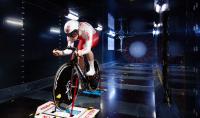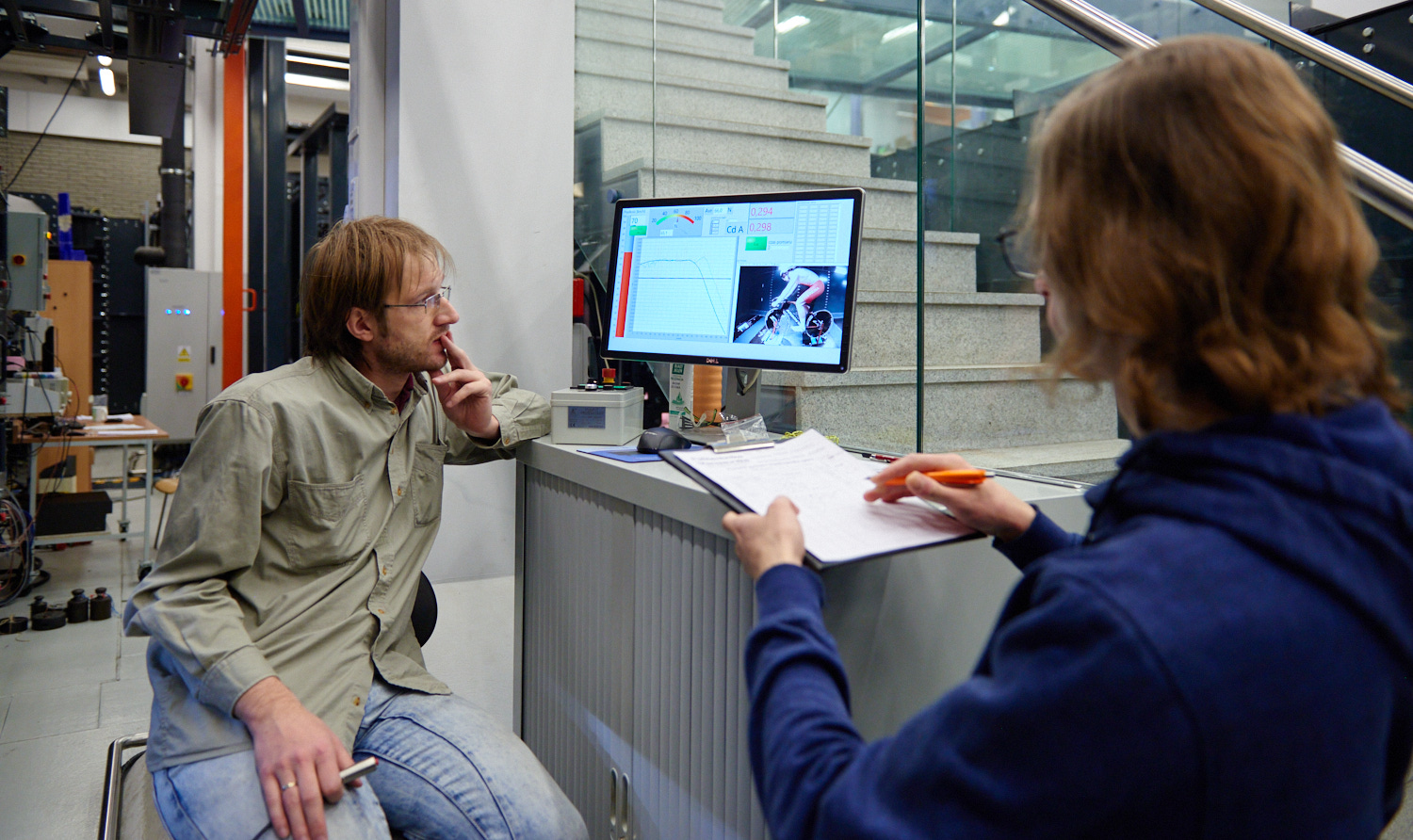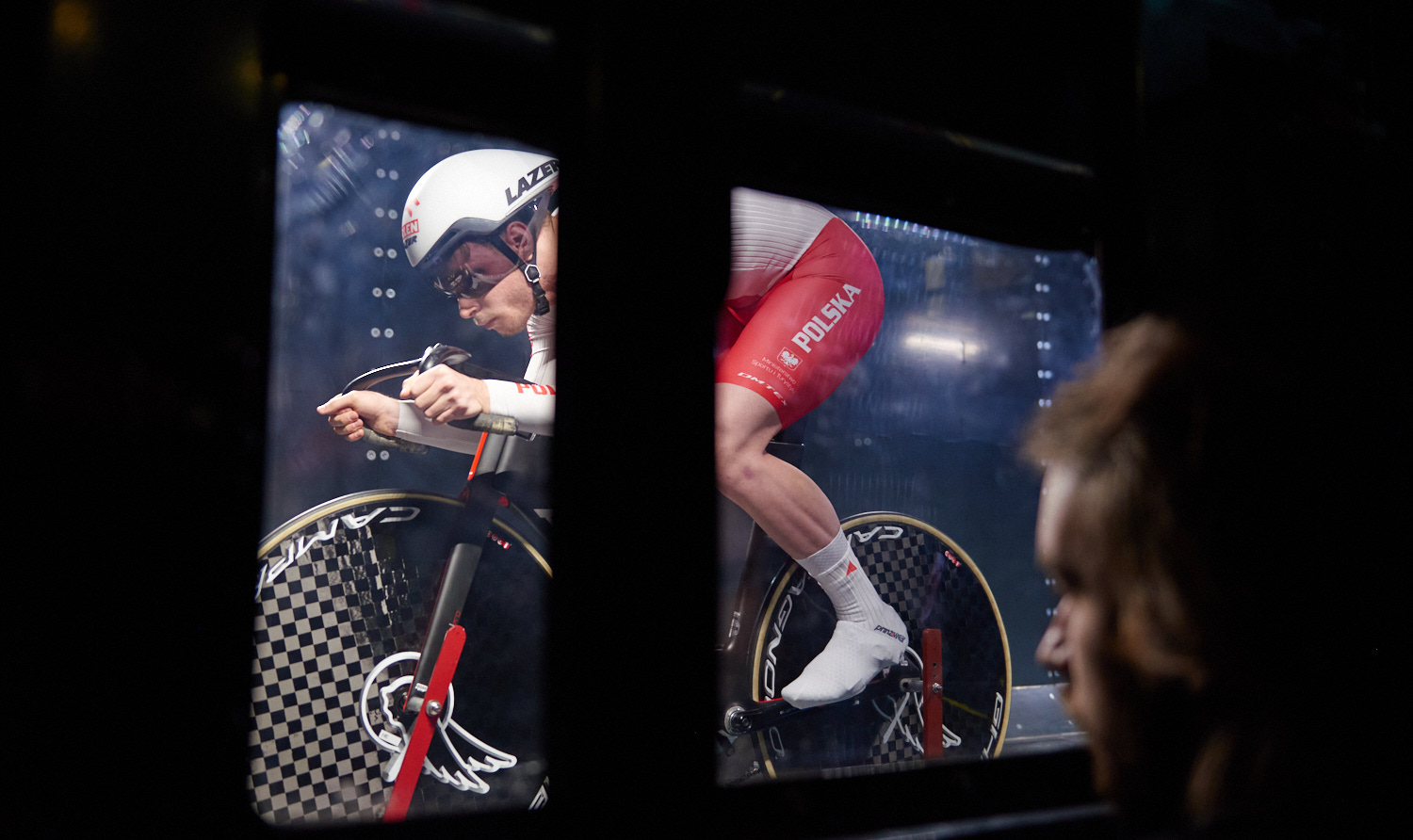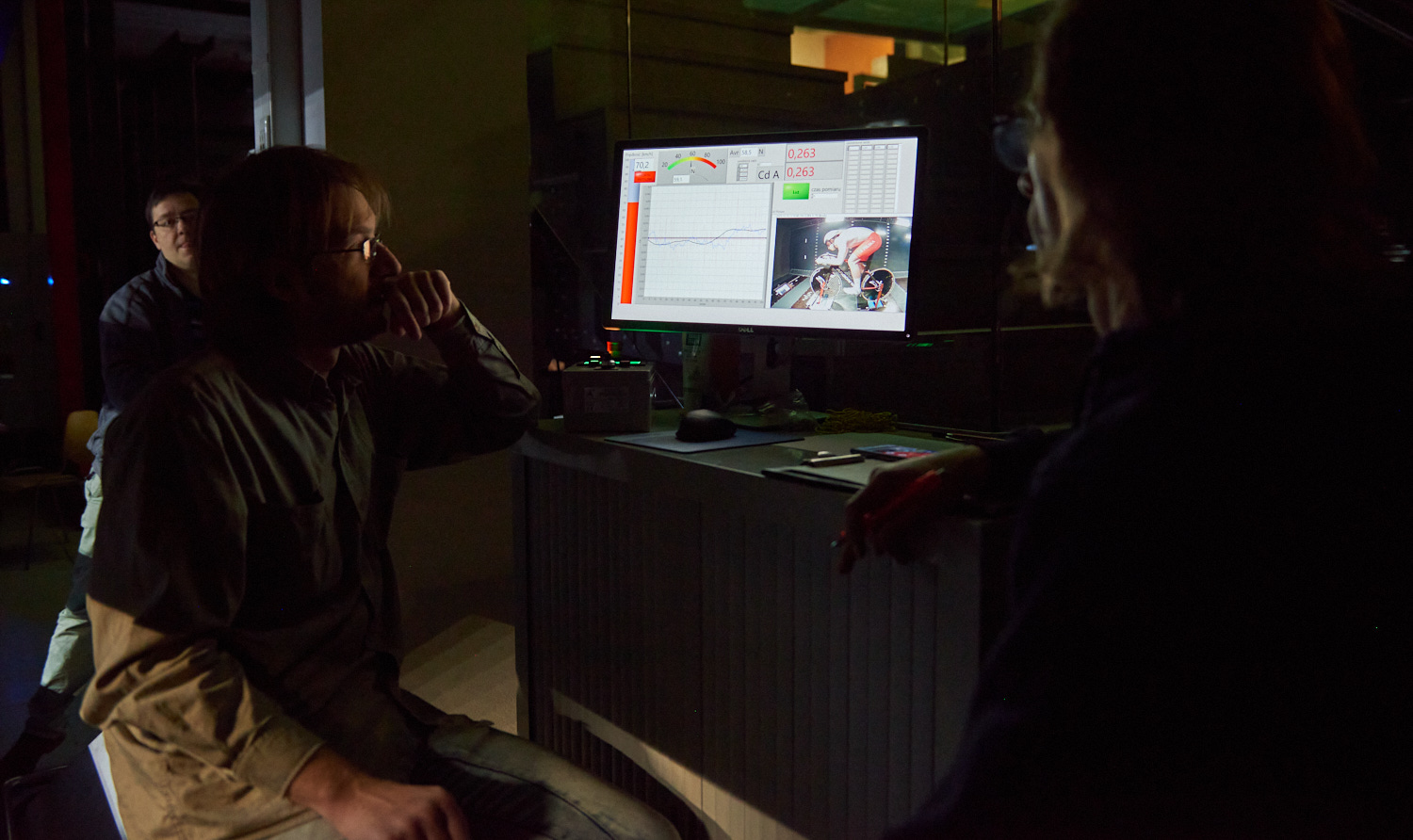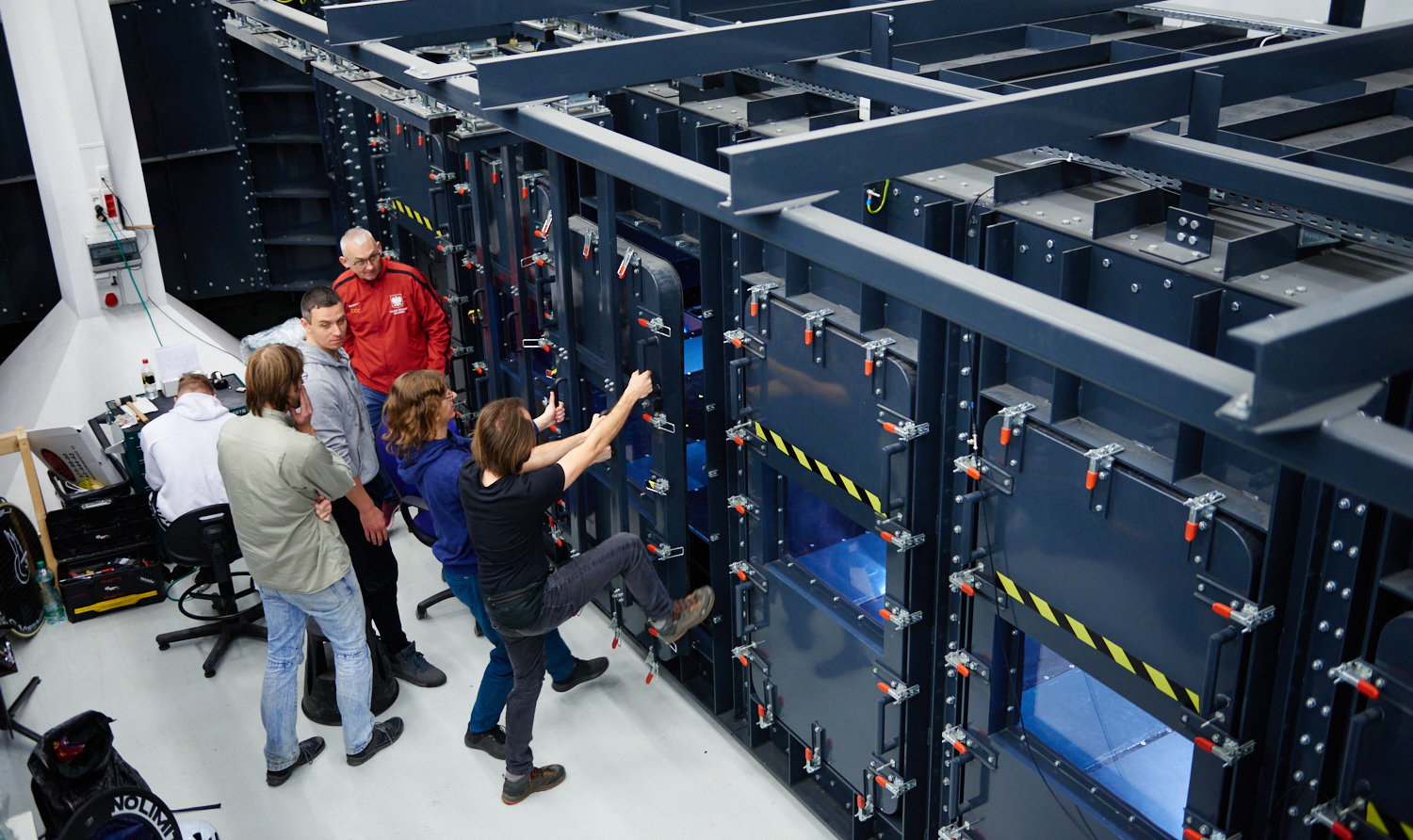Cyclists doing tests in WUT’s wind tunnel
Success in sport is determined by details. Scientists are increasingly helping sportspeople to find reserves and advantages. Track cyclists from the Poland team came to the Warsaw University of Technology to participate in the research. They were looking for the right equipment settings and the optimal position on the bike. They will use the results in training and competitions.
We walk into the building of WUT’s Institute of Aeronautics and Applied Mechanics. It is one of the two institutes that make up the Faculty of Power and Aeronautical Engineering. We walk through the corridors. Up, down, left, then up again, right... Finally, we meet Konrad Gumowski, and soon after also Michał Remer from the Laboratory of Aerodynamics of Aircraft Turbines and Combustion. We had an appointment. In WUT’s wind tunnel, track cyclists are currently being tested, and we will observe them.
We walk into the lab. It takes up two floors – we go downstairs, into the wind tunnel. The entire lab on the bottom floor takes up the area of some 450-500 m2, and the mezzanine and walkway another 60-70 m2. At first glance the wind tunnel looks very much like a train carriage. Its dimensions are 26.1 x 8.3 x 2.9 m, and the measuring section where the research takes place is 11.2 x 2.6 x 2.0 m.
Talks between WUT specialists and cyclists & coaches are underway. The next measurement is about to begin. One of the competitors enters the tunnel. He sits down on a bike installed there. Now he has a moment to prepare.
- Are you ready?
- Yes, now!
- Good, we’re closing the door.
Two people appear at the entrance to the tunnel. 5, 4, 3, 2, 1 – heavy doors close, computers get to work, the space is filled with a powerful monotonous noise.
Through the door we see a cyclist. At the beginning, seemingly nothing happens – this is the so-called static measurement. The competitor sits on the bike and checks his position – he is looking for the most aerodynamic one, the one that will allow him to gain valuable fractions of seconds in the competition, overtake competitors, and perhaps win him a medal. Only after a while does the cyclist begin to pedal (this is of course the dynamic measurement). Over the course of a single series, seven measurements are made (each lasting 30 seconds): four static and three dynamic.
What’s the resistance?
- The tunnel is used to generate air flow at a given speed, in the case of cyclists we set it to 70 km/h, which corresponds to the speed achieved on the track during a sprint, explains Bartosz Olszański from the WUT team dealing with the tests in the tunnel. - At this speed, the cyclists assume a system of static and dynamic positions and we check what dimensionless drag coefficient (CD) or dimensional resistance coefficient CDA characterises particular positions. Thanks to this, we can check the position of the cyclists on the bike and find the optimal setting. Yesterday we also tested the equipment: overalls, helmets, cockpits.”
The measuring station consists of two parts: inside and outside the tunnel.
- In the middle there is a part that the cyclist has contact with: the system for measuring the resistance force, the suspension on which the bike rests, and the monitor on which the cyclist can observe the indications of the drag coefficient and his position on an ongoing basis, says Piotr Czubak. - Outside the tunnel, we have a measuring station that is used to direct the research. There, we verify whether the cyclist has already taken a stable position and we can start the measurement or decide to stop.
A medal station
The tests in the WUT wind tunnel are carried out by a small team: Bartosz Olszański, Piotr Czubak and Bartosz Załęcki, supported by the head of the entire laboratory, Konrad Gumowski, and Michał Remer.
Just performing tests – such as those with cyclists – usually takes 1 to 3 days. This is often work from morning to late evening. However, before the cyclists even appear at the tests, our specialists must prepare for them. Some solutions are non-standard, so it is crucial to adapt the measuring station to the needs of a given group of athletes. The one used by cyclists is the project by Piotr Czubak and Bartosz Załęcki.
- Both the cyclists and ourselves are satisfied with the final result, stresses Bartosz Olszański. - I think that this position does not differ in standard from those that can be found in wind tunnels in Western Europe.
After the tests, it’s time to process the results. Processing such a large amount of data, as in the case of research with cyclists, takes about a month of intensive work.
We check everything
Let’s take another look at the test itself. How does it all work?
- The basic measuring element is two strain gauge beams that register the change in resistance under the influence of force, explains Bartosz Olszański. - In order to read the signal with the appropriate frequency and resolution, we use measurement cards that are connected to a computer. On the computer we have an integrated data acquisition system responsible for reading indicators like speed, temperature, and humidity from the tunnel. Thanks to this, we convert it into density. Having the density and velocity, we can calculate the dimensional drag coefficient CDA.
That’s the key in this research.
- Our software is used to save, reduce and catalogue data, adds Bartosz Olszański. - We also have a camera that takes pictures in perspective, from the side.
Then, during data processing, you can pair a corresponding digit (i.e. the resistance coefficient) with the cyclist’s position and find out if it was the change in setting that caused the change in the coefficient.
Small change, big effect
It’s time for another measurement series. Bartosz Olszański, Piotr Czubak and Bartosz Załęcki return to work. We take the opportunity to talk to Kamil Kuczyński – assistant coach in the team of track cyclists, and up until recently a full-time representative of Poland at the most important sports events, most notably the Olympic Games.
- Testing a single cyclist takes from two to four hours, says Kamil Kuczyński. - We compare the different positions a rider takes on a bike. In each measurement, we introduce one change to check which factor gives at least a minimal advantage. We look for differences in bike settings, in the position of hands, or even in the type of shoes.
Wind tunnel testing is the first step in the process. After receiving the report, there will be time to implement the results in training on the track, and then they can be used in tournaments, when there is competition, adrenaline is buzzing and it’s easy to forget about the right technique.
- In the tunnel, the cyclists can see with their own eyes the real differences caused by their position: their head, hand or knee, says Kamil Kuczyński. - They are often surprised at how a small change has a positive effect on reducing air resistance.
Success is born in the tunnel?
The first research on athletes in the wind tunnel at the Warsaw University of Technology took place in 2016. During this time we have already hosted cyclists, as well as speed skaters, downhill skiers, and tobogganers. The tests are possible thanks to the initiative and support of the Polish Ministry of Sport, the Polish Olympic Committee, and specific sports associations.
- We try to ensure that the knowledge gained from our research, especially when it comes to an awareness of the role of aerodynamics in the final result, stays with the competitors and that the work done with us helps them in achieving success, emphasizes Bartosz Olszański.




